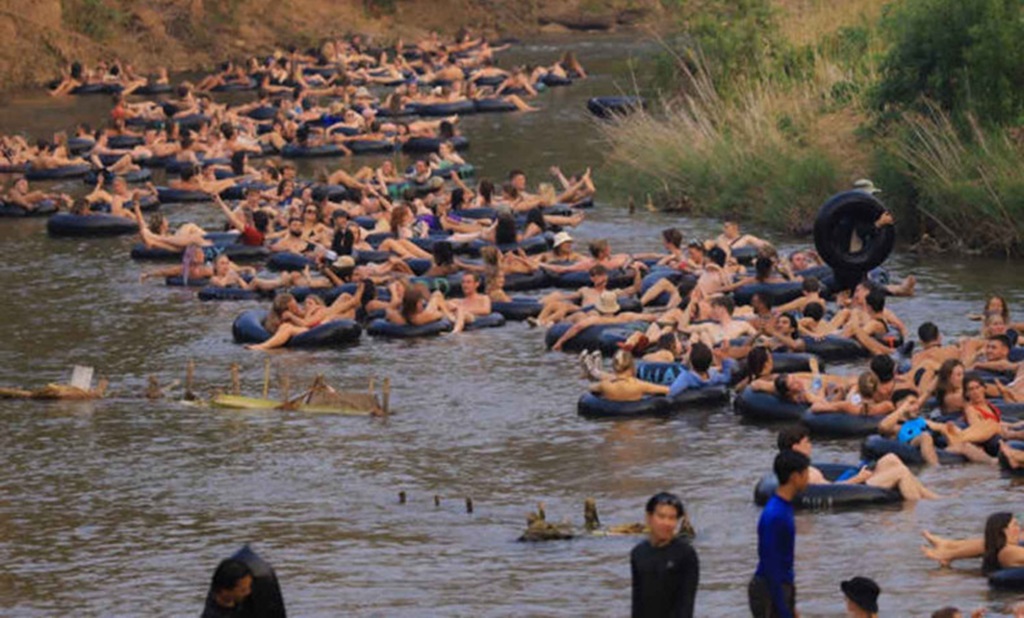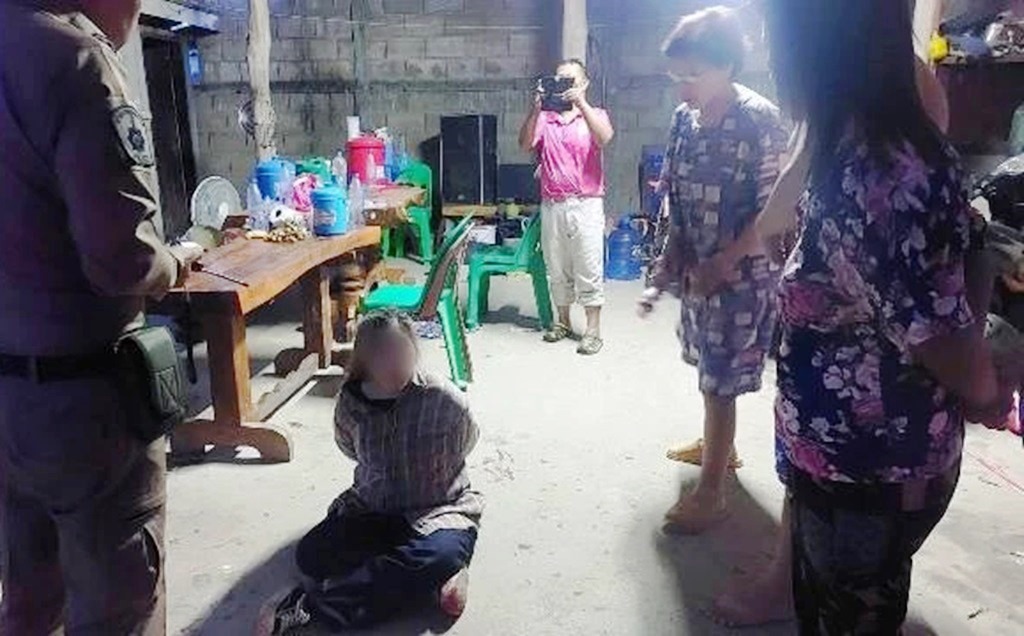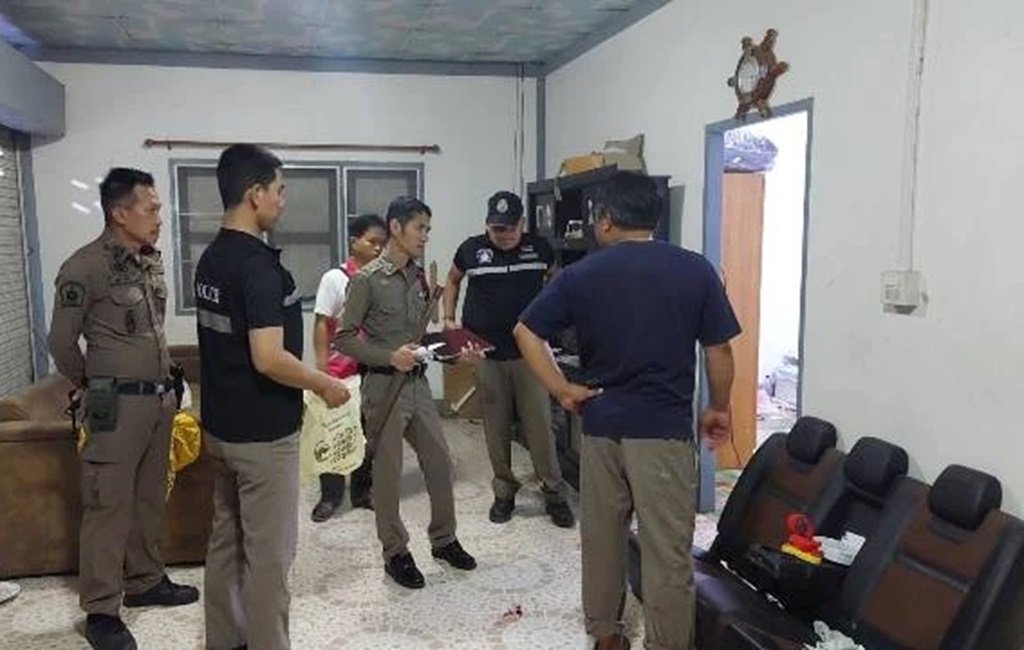Northern Thailand
Myanmar Refugees in Thailand face Uncertain Future as Country Re-Opens
TAK – Since the day she was born, 20-year-old Naw Lawnadoo has known almost nothing of the world beyond the fence and guard posts that hem her in with 45,000 others – ethnic minorities from Myanmar and those like her who were born and raised in the Mae La refugee camp in neighboring Thailand.
School, family, friends, shopping and churchgoing – many of the refugees are Christian – have all been confined to a valley of densely packed bamboo-and-thatch huts huddled under soaring limestone cliffs.
Saw Pa Taw, left, a former Karen fighter who lost both his eyes and hands, during fighting with Myanmar soldiers talks as and son Ta Ye Thu, 13, listens during an interview at Mae La refugee camp in Ta Song Yang district of Tak province, northern Thailand.Now, she and other camp residents face a future that will dramatically change their constricted but secure, sometimes happy lives. With the end of 50 years of military rule in Myanmar, aid groups are beginning to prepare for the eventual return of one of the world’s largest refugee populations – some 1 million people in camps and hideouts spread across five countries.
For thousands like Naw Lawnadoo, it is “repatriation” to a country they have never known, where their parents suffered under a military regime that suppressed ethnic insurgencies with brutal tactics, and where ethnic tensions continue to erupt in bloodshed despite some democratic reforms. More than half the population of the camps in Thailand is under 19.
“We are prepared to go back, but we don’t know what the real situation there is like,” says Naw Lawnadoo of the country previously known as Burma. “We can’t speak Burmese. We have no identification cards. And I don’t know what kind of a job I could get.”
Just when they will have to leave remains uncertain, but Thailand, which hosts many of the camps, is eager to close them.
“We’re coming to the endgame,” says Sally Thompson, executive director of The Border Consortium, the main agency providing aid to a string of Thailand camps, where you can find four generations living under one roof.
Some may melt into Thailand, joining the 2.5 million migrant workers from Myanmar. A few may be resettled in third countries, though the United States is ending a program under which it has taken 80 percent of the 105,000 settled so far. With shrinking options, most will likely have no choice but to return.
There have been Burmese refugee camps in Thailand for more than 20 yearsWhile camp life is hardly cosmopolitan, some of the young can meet foreigners, have access to the Internet and occasionally slip out to a nearby town, or even the shopping malls and bright lights of Bangkok, Thailand’s capital. For them, the prospect of planting rice in isolated villages to which they would probably go holds little attraction.
Naw Lawnadoo for one is seemingly confused. The young woman, dressed in neat slacks and a blouse embossed with a teddy bear, has heard the stories of how her parents fled Pea Ta Ka village in Karen state as Myanmar soldiers moved in to pillage, burn houses and kill.
At one moment she says she would like to go to Australia, where her father’s three sisters and mother are settled, after finishing her studies at a Baptist college in the camp.
Later, she talks about returning to her mother’s village in Myanmar as a medic or Christian missionary, thinking that perhaps she could adjust to life there. “If our neighbors could live like that, we could too,” she says.
She and her parents had an opportunity to go to Australia earlier, but decided against it because her maternal grandmother still lives in Myanmar. “My mother didn’t want to go. She said we would be even farther from her mother than we are now, and my father gave in to her,” Naw Lawnadoo says with a distinct note of regret.
Mu Pro, a 42-year-old Karen refugee weaves while talking during an interview at Mae La refugee camp in Ta Song Yang district of Tak province, northern Thailand. Karen refugees are now facing a future that will dramatically change their constricted but secure, sometimes happy lives“I’ve never ridden a train or an airplane,” she says. Her longest trip and only one to a city was to Chiang Mai in northern Thailand.
The majority of the refugees, including Naw Lawnadoo, belong to the Karen ethnic group. Others include the Karenni and Pa-o. Many of the older ones, who fled fighting in their homelands, hope to return one day but say the time is not yet right.
Myanmar remains a nightmare for Mu Pro, a 42-year-old woman. She still dreams about running, running, trying to flee the grasp of her pursuers who finally catch and torture her.
“No more Burma army. No more torture. No more killing. No more suffering,” she says. “I don’t want to go home. Since I was young, I have always been running away from Burmese soldiers.”
Her aging father, like many in the war-torn regions, was forced to be a porter for the army and shot when he could not carry his load. When her husband, also shanghaied, never returned she fled her mountain village. She sent two of her sons to Thailand, while she and three younger children became internal refugees – like some half a million others in eastern Myanmar – for 11 years. Always on the move, they hired themselves out to feed pigs and plant rice.
When they finally arrived in Mae La, the deadline set by Thailand for refugees to register for possible resettlement to third countries had passed, though her two sons left for Australia with a friend a year ago.
Karen girl peers from her bamboo hut at Mae La refugee camp in Ta Song Yang district of Tak province, northern Thailand.“I don’t trust the SPDC and I fear armed conflict will erupt again,” she says, still using the acronym for the now defunct military junta, some of whose former leaders continue to wield influence. The government has signed a series of fragile cease-fires with many of the insurgent groups, but some have already frayed, with clashes having recently erupted in Shan state and the Kachin still fighting the government. Soldiers are likely to remain in Karen state for the foreseeable future.
The Karen Refugees Committee, a leading refugee organization, recently said the reforms in Myanmar “signal a ray of hope for many refugees to be able to return to their homeland,” but laid down 10 conditions for repatriation ranging from a solid nationwide cease-fire to clearing the vast mine fields along the border.
Thompson cites a host of problems in Karen state and other ethnic regions, ranging from rehabilitating communities shattered by conflict to mounting land grabs that have turned the homes and fields of farmers into plantations, factories and dam sites. Some refugees who go back to check their old properties say they no longer exist, and they have no documents to reclaim them.
But she also says that “suddenly something will be triggered and they’re off so we have to be prepared for that moment.”
Thompson, who has worked with border refugees for more than two decades, says forced displacement of villagers has dropped dramatically and there are fewer military checkpoints, allowing people to move around more freely. Refugees crossing into Thailand have slowed to a trickle.
To prepare for an eventual return, aid groups are boosting refugee skills, from building sturdy houses to creating business plans for small enterprises to monitoring cease-fire and human rights violations. This, along with the uncertain timetable for repatriation, has also stoked unease.
“We have shifted our thinking from taking care of refugees to their return,” she says. “There is hope now for the first time in decades.”
Northern Thailand
Tubers on Pai River Draw Anger Over Inappropriate Behavior

The Governor of Mae Hong Son province in northern Thailand has sought stricter rules for tourist tubing on the Pai River, following allegations of tourists sneaking into resort areas to engage in sexual activities, which prompted police reports and considerable criticism online.
After a resort owner in Pai protested about the existing situation of tubing activities along the Pai River, the Governor became aware of the matter. According to the accusations, wine and beer are discreetly offered to tourists while disguised in plastic water bottles to prevent detection.
After their tubing adventures, these tourists, both men and women, would walk around Pai town in their swimsuits. Men often wear one pair of swim briefs, but most women wear two-piece swimsuits or bikinis.
This behavior was considered derogatory to local culture. Recently, there were instances of tourists slipping into resort areas to engage in sexual activities, which prompted police investigations and considerable online criticism.
Following the complaint, provincial governor Chuchip Pongchai requested a meeting of the police and allied authorities on July 16 to explore further tourism restrictions.
The province already restricts the selling of alcohol to tourists who go tubing, which involves floating down a river on inner tubes made of rubber tires. Most people observe the guidelines, but others, including some store owners, break them by concealing the alcohol by pouring it in water bottles.
According to TNA, Pai is one of Northern Thailand’s most popular tourist spots, attracting 40,000 visitors each year and strengthening Thailand’s economy.
Tubing in the Pai River has become a favorite activity among foreigners. However, the governor stated that the attitude of some tourists has jeopardised the province’s image.
Tourists Tubing on Pai River
People Also Reading:
Girl 16 Arrested in Thailand for Defaming Royalty on Facebook
Girl 16 Arrested in Thailand for Defaming Royalty on Facebook
Northern Thailand
Pregnant Woman Goes Psycho Stabs Family Members in Phayao

Police in northern Thailand’s Phayao province have arrested a 40-year-old pregnant mother for attempted murder and assault with a deadly weapon with the intent to create bodily harm.
Phayao Police report they were called after a woman and her daughter had been stabbed and beaten by a family member to a house number 206, Soi 7, Village No. 3, Ban San Nong Niao Subdistrict. Tom, Mueang District.
When officers arrived they found Ms. Chayada Chaiyawan, age 45, and her daughter Ms. Patida Chaiyawan, age 19, with injuries to their bodies and heads. Blood was spread all over the bedroom, and they found Mrs. Sakulkarn, aged 40 years, who was a relative living next door, tied up.
The police then transported all of them to Phayao Hospital for treatment. Ms. Chayada was stabbed thirteen times and her daughter twice. Both also sustained head injuries, according to Phayao police.

Ms. Chayada told police the incident occurred around 4:00 a.m. She was sleeping in the room with her young son, when she heard someone opened the bedroom door. She said at that time it was still dark and all she saw a shadow of a person lifting what she though was a hammer.
She said the got up and fought until she fell after being hit in the head and stabbed with a knife, in fear for her life she screamed for her daughter to come and help. When the daughter entered the room the assailant proceeded to hit her in the head and stabbed her also.
The assailant ran out of the room and was immediately restrained by a neighbour who heard the screaming and ran into the house to help. Mrs. Sakulkarn who was 7 months pregnant was tied up and police and rescue workers were called to the scene. The neighbour told police that all the time they were waiting for the police.
Police said Mrs. Sakulkarn is being held in Hospital and is under psychiatric care. Ms. Chayada and her daughter were treated for their injuries and sent home.
According to Thai Media, Police said charges of attempted murder and assault with a deadly weapon with the intent to create bodily harm will be filed against Mrs. Sakulkarn after she is released from Hospital.
People also reading:
Phayao Gets City-Class Air Purification Tower for Air Pollution
Phayao Gets City-Class Air Purification Tower for Air Pollution
Northern Thailand
Train Crashes into Pickup Killing 5 in Phitchit Province

Five people were killed and two others badly injured when a pickup truck was hit by a north-bound train at an unguarded railway crossing in Phitchit province on Monday evening.
Phitchit police reported the horrific crash occurred around 6 pm at Moo 1 village in tambon Pak Thang of Muang district of Phitchit.
Police said the 201 passenger train from Bangkok to Phitsanulok approached the crossing, which was unguarded and had no safety barriers.
A four-door pickup truck plates drove across the tracks and into the path of oncoming the train which was was unable to stop or slowdown in time to avoid hitting the pickup truck.
The force of the crash drove the pickup about 30 metres down the railway crossing and off to the side. All passengers on the pickup were thrown from the vehicle.
Three women passengers died immediately and two more passengers died later at Phichit Hospital. Two others including the driver of the pickup were seriously injured.
Police investigators said truck driver Pratya Khongthat, 40, was taking relatives, including a 14-yea-old girl, to a funeral at Wat Ratchangkhwan in tambon Pak Thang, approximately one kilometer from the accident scene.
People Also Reading:
Bangkok-Vientiane Inaugural Train Service Launches July 19
-

 News3 years ago
News3 years agoLet’s Know About Ultra High Net Worth Individual
-
Entertainment2 years ago
Mabelle Prior: The Voice of Hope, Resilience, and Diversity Inspiring Generations
-

 Health3 years ago
Health3 years agoHow Much Ivermectin Should You Take?
-

 Tech2 years ago
Tech2 years agoTop Forex Brokers of 2023: Reviews and Analysis for Successful Trading
-

 Lifestyles2 years ago
Lifestyles2 years agoAries Soulmate Signs
-

 Movies2 years ago
Movies2 years agoWhat Should I Do If Disney Plus Keeps Logging Me Out of TV?
-

 Health3 years ago
Health3 years agoCan I Buy Ivermectin Without A Prescription in the USA?
-

 Learning2 years ago
Learning2 years agoVirtual Numbers: What Are They For?
